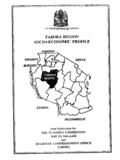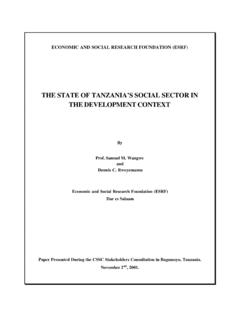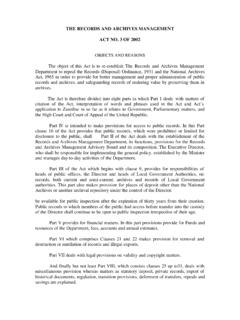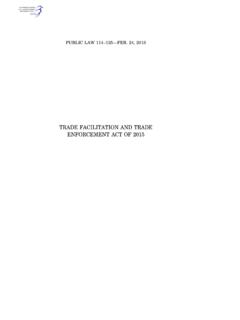Transcription of VOCATIONAL EDUCATION AND TRAINING AUTHORITY …
1 VOCATIONAL EDUCATION AND TRAINING AUTHORITY (VETA) united republic OF TANZANIA INTEGRATED TRAINING FOR ENTERPRENEURSHIP promotion I N T E P REACHING THE TARGET GROUPS IN THE INFORMAL SECTOR Dar es Salaam, 3rd November 2000 Bernadetta Ndunguru, Director for VOCATIONAL EDUCATION and TRAINING , VETA Ewald Gold, Gesellschaft f r deutsche Zusammenarbeit (GTZ), GmbH TABLE OF CONTENTS 1 INTRODUCTION 1 2 TRAINING APPROACHES 1 3 INTEGRATED TRAINING FOR ENTREPRENEURSHIP promotion (INTEP) 2 4 EXPERIENCES 3 5 STRENGTHS 5 6 FUTURE PROSPECTS 5 1 INTRODUCTION Like in many other African countries, the formal labour market in Tanzania is small and decreasing even more as a consequence of the economic and social adjustments during the last 15 years.
2 The formal labour market is profoundly imbalanced as 45% of the total population is under 15 years of age. More than 500,000 young people are entering the job market each year while the number of jobs created in the modern wage sub-sector may perhaps be less than 30,000 per annum. In 1990/91 the informal sector (IS) offered employment for million people, which was more than twice the number employed in the formal sector (government, para-statals and private firms). Only out of the total number of operators had formal TRAINING . Formalised TRAINING for the formal sector is a national requirement however it has only a very limited relevance for the employment chances of the majority of people who generally have no access to TRAINING .
3 As a supplement to the formal TRAINING integrated non-formal TRAINING can help to qualify various target groups to acquire technical, business and communication skills. At has to be job- and market-related, short and inexpensive. 2 TRAINING APPROACHES The VOCATIONAL EDUCATION and TRAINING AUTHORITY (VETA) in Tanzania has adopted a new TRAINING system a Competency Based EDUCATION and TRAINING (CBET) system. The CBET approach enhances effectiveness and efficiency of VET through: Comprehensive approach which enables adaptation of TRAINING to the needs of the labour market. For example, entrepreneurship TRAINING and cross cutting skill are an integral part of TRAINING delivery to allow translation of technical skills into business and ensure the desired market oriented competency.
4 Modularised TRAINING which allows the trainee to choose specific separate TRAINING units, according to the skills needed for employment, or to go for the full cycle of units. In the first case, the successful participation of each unit is certified separately, in the second case, the trainees will receive the full trade recognition after the completion of all the required TRAINING units. Within this process of modularising the existing formal TRAINING curricula. Non-formal TRAINING whereby TRAINING packages are specifically designed for selected target groups they address, by choosing existing TRAINING units of the curriculum of the respective occupation or developing tailor-made TRAINING programmes.
5 The timing of non-formal TRAINING is adapted, so as to fit into the trainees' commitments as a business operator or employee, in evening classes. The successful participation in a course is certified accordingly. Lately, VETA has been increasing its offers of non-formal TRAINING , especially for commercial trades and to a lesser extent for technical skills. 3 INTEGRATED TRAINING FOR ENTREPRENEURSHIP promotion (INTEP) INTEP is a target group oriented TRAINING facilitation. Among the components of the VET concept, this one has been initiated most recently. The objective is to create TRAINING offers, which target existing MSE operators within the informal sector and with a special focus on gender balance.
6 Slightly different from the CBET concept the target group is taken as a starting point, from which local and regional market options and employment opportunities are assessed. For the development of INTEP packages the following aspects must be taken into account: Desired geographic scope: For the purpose of developing TRAINING offers geared to the needs of the informal sector, a local or at most regional perspective seems to be most fit. However, even if the major focus is on the local level, an efficient linkage between local producers and the regional markets should be taken into account as a decisive criterion for the prospect of local initiatives.
7 Situation of labour and goods market: In order to ensure employment effective-ness, the labour market and technological situation in the environment of the target groups have to be observed and market niches or trends of saturation be identified. Characteristics of the target group: The analysis should focus on the socio-economic environment the individuals and groups live and operate in, as well as characteristics such as age, sex, EDUCATION , work experience, as well as their educational and TRAINING background, their interests and ambitions. This has to be assessed through analysis and thorough dialogue with the group.
8 Existing local TRAINING institutions and support structure: The review should lead to an overview about the level of qualifications, about TRAINING location and duration, about TRAINING cost, certification, the balance between theory and practice, the number of trainees, as well as the recruitment of trainers. In many cases it may be necessary to include qualification and support to the planners, facilitators and trainers of those institutions. 4 EXPERIENCES Following the development of this methodology, first experiences were made in several regions of Tanzania, which should pave the way for situation-specific replication of the methodology.
9 It was the intention of the pilot programme to reach target groups with low levels of EDUCATION and to give a special thrust to the development of TRAINING options for girls, women and youths. For the pilot phase the field of preservation, storage and processing of food was identified as an area of presently untapped marketing opportunities. For the curriculum planning process competent institutions were identified, which were interested and competent in participating. Planning teams consisting of representatives of different TRAINING providers, individuals with know-how in planning, TRAINING , food processing, as well as in marketing and packaging elaborated the specific TRAINING programmes, following a special methodology.
10 On the basis of the above insights, an INTEP programmes, including a curricula outline, as well as TRAINING areas and features were designed. The matching of the needs and qualifications of the target groups with the demands of the markets for labour and goods is an essential. In order to reach the identified target groups VETA aims at enabling those institutions with new competencies to function as initiators and implementors of such tailor made TRAINING programmes. Summarised, the services delivered by VETA/GTZ were: TRAINING of VETA staff as facilitators Targeting of beneficiaries (selection/approval of suggested target groups) Improving the qualifications of TRAINING providers in planning and implementation of TRAINING Development of TRAINING packages Financing, co-ordination and evaluation of pilot programmes Strengthening links to other relevant service providers (micro finance, business counselling, etc.)

















